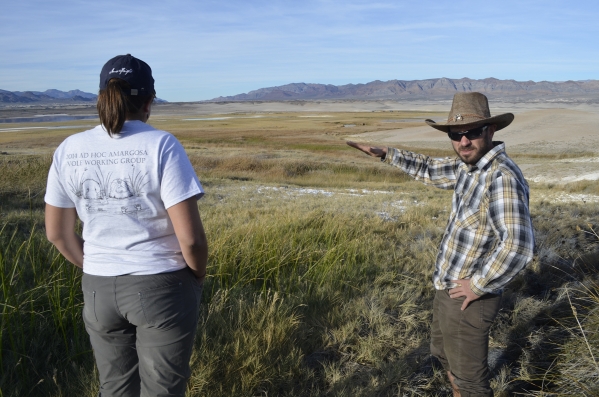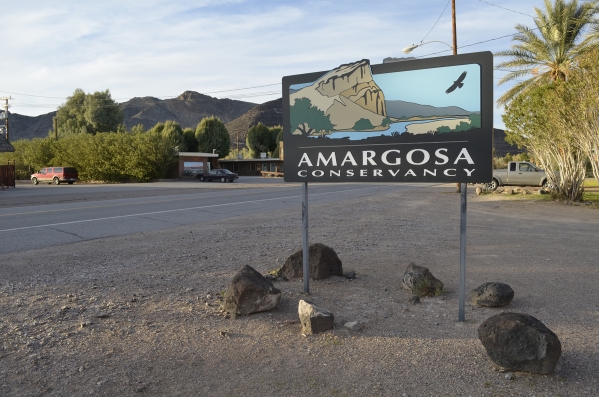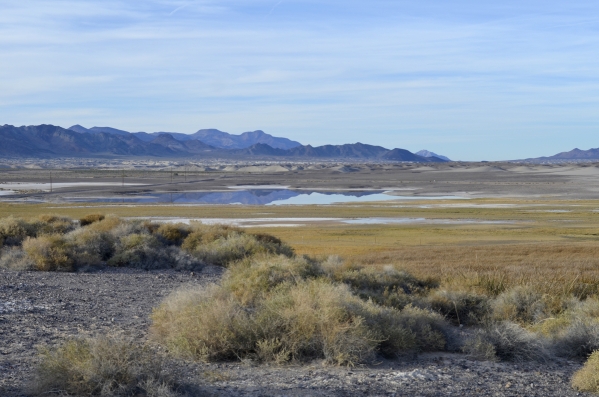Amargosa Conservancy voices concerns on renewed Yucca Mountain push
The azure sky rims browned up grassland that stretches across several miles of Tecopa, a tiny hamlet in the southeast corner of Inyo County, California that thrives on ecotourism. The surreal quietness is occasionally interrupted by the gentle whoosh of passing cars or birds making their way to the Tecopa marsh, one of the most unique habitats in the world.
The area that is made up of the mix of sunburned hills and desert flatlands is located about 80 miles southwest of the proposed Yucca Mountain nuclear waste repository in Nye County. The project was mothballed by the Obama administration in 2010, but a study completed by the Nuclear Regulatory Commission in August concluded that the nuclear waste dump would present only a "negligible increase" in health risks from nuclear particles that might leak into the groundwater.
In neighboring Shoshone, a former mining town with a population of 30, Patrick Donnelly, the executive director of the Amargosa Conservancy, a local nonprofit organization, argues that the NRC study failed to address the potential impact on the livelihood of Shoshone and Tecopa.
"For the past 40 years, since the environmental review process began on Yucca Mountain, the idea was that all the groundwater coming down here from Yucca Mountain down to the Amargosa Valley and then it would flow off this way into Death Valley," Donnelly said. "And so, for 40 years, when people were assessing environmental impacts of Yucca Mountain, they only really looked at Furnace Creek and Badwater and the Death Valley area."
The summary provided by the NRC study says that the principal natural discharge site under present conditions for groundwater potentially contaminated by releases from a repository at Yucca Mountain is Furnace Creek or Middle Basin of Death Valley. Minor discharge sites for contaminants include Alkali Flat, a broad area south of Amargosa Farms along the bed of the Amargosa River and the area of the state line deposits.
James Rubenstone, acting director of Yucca Mountain Directorate at the office of Nuclear Material Safety and Safeguards, said the groundwater at Shoshone and Tecopa is not affected by water in the aquifer beneath Yucca Mountain and the areas would not be affected by potential contaminants, according to the analysis that used the most recent version of the groundwater flow model developed by the U.S. Geological Survey.
"At the meeting (in Amargosa Valley), Patrick said that he thought that the groundwater at Shoshone and Tecopa would be affected," Rubenstone said. "The report he provided to support this idea is what we are looking at now to see if we need to change our analysis."
Report
A 2014 state of the Amargosa River basin report funded by the Amargosa Conservancy and prepared by hydrogeologist Andy Zdon claims that while the Nevada portion of the Amargosa River basin has been well studied as a result of hydrologic studies centered on the Nevada Test Site and the Yucca Mountain Project, the California portion of the basin has seen little in the way of regional hydrogeologic investigations.
"Given the absence of review of more recent investigations over the past five years, and the now recognized greater influence of alluvial groundwater from Amargosa Desert and the Ash Meadows area on the Shoshone-Tecopa area, the Shoshone-Tecopa area is poorly represented in the analysis," Zdon said about the NRC report on Yucca.
Zdon said that chemical samplings of springs and wells in the Shoshone-Tecopa area show that Shoshone Spring, the water supply for the town of Shoshone and Borax Spring to the south are largely the result of groundwater moving southward from the Amargosa Desert and Ash Meadows region.
"Impacts to the Amargosa River and springs would not only have serious environmental consequences, but could also threaten the economy of the area," he added.
In the meantime, Director of Nye County Nuclear Waste Project Darrell Lacy said the NRC environmental impact statement supplement validated the assumption that potential exposure was less away from Yucca Mountain.
"So, someone in Tecopa gets less exposure than someone in Amargosa," he said. "The amount at the fence line is so small that it is difficult to calculate any adverse health impacts, so people farther away will have less impact."
Lacy also cited the DOE and national lab studies that had found the potential contamination to be "very small."
"Small as less than one percent of the natural background radiation at the fence line to the reasonably maximally exposed individual," he said. "The model is conservative and assumes the first drop might get out of the mountain in 10,000 years. Most likely it will be at least 100,000 years, if ever."
The data compiled by Zdon hadn't been included in the NRC study, but Donnelly said if it was, the commission could have arrived at different conclusions.
"This information has the potential to completely revise the entire environmental report for Yucca Mountain because the whole thing has been premised on the idea that all this water goes (to Death Valley), and we are now conclusively demonstrating that some portion of this water comes to (Tecopa and Shoshone)," he said.
Economy
Donnelly describes the situation in Tecopa and Shoshone as "environmental injustice."
The lack of political power in the two towns that derive most of their revenue from tourists stopping on their way to Death Valley and occasional snowbirds makes it easy to ignore the data and potential impact of the proposed repository, he said.
"It's much easier for politicians and policymakers to put these things with negative environmental impacts near impoverished communities because who has the power to stop that if you don't have any money and you don't have any political representation," he said.
According to the 2010 report that outlines socio-economic impacts of the proposed Yucca Mountain high-level nuclear waste repository on Inyo County, tourism, the largest driver to the county's economy would be severely affected by the project.
Upon initial announcement of the repository's operation, officials estimate a drop in visitation to the county between 17.3 and 26.3 percent. Consequently, if a minor radiation release occurs anywhere in the transportation system in which material is transported from the many nationwide sites where it's now stored to the repository, an estimated drop in visitation stands between 29 and 57 percent, the report says.
"Should the Yucca Mountain repository for high-level nuclear waste become operational, its impacts on Inyo County's people, economy and local public sector fiscal base will be unique in that these impacts will all be negative," the report said. "We found no evidence that the project, with the repository located about fifteen miles from southeast Inyo County, will provide any benefits to the county's socio-economic base. The evidence is clear, however, that as soon as the repository becomes operational, visitation to the county will decline."
For the severely disadvantaged communities of Tecopa and Shoshone, this could have devastating economic consequences, Donnelly said.
"If we were to lose 60 percent of our visitors, I firmly believe that not only would all of our businesses shut down, I think everyone would move away because there would be zero jobs left," he said. "So, I think you wouldn't just have an economic collapse in southeast Inyo County, but you'd actually have a wholesale depopulation, that we would no longer have residents here because there would no economy. The entire economy would be shuttered, if 60 percent of the residents stopped living here."
The 2010 census demographic report shows that Tecopa had the highest poverty rate, 20.5 percent in Inyo County while Shoshone didn't report any people living in poverty. Inyo County's poverty level stood at 10.9 percent, the data shows. Its median income of $44,952 was lower than all of the surrounding California counties and California's overall median income of $60,392.
Kevin Carunchio, Inyo County administrator said the county has not taken an official stand to support or oppose the repository, but is concerned that if the repository is constructed that all possible impacts, particularly potential to impacts to groundwater and the county economy in southeast Inyo County, be "identified, fully analyzed, and mitigated."
"We are concerned about potential impacts to regional groundwater supplies, as well as the local economy," Carunchio said in a statement. "Economic studies undertaken by the county show the repository could negatively impact tourism in the area."
Meanwhile, the report shows that employment in the leisure and hospitality industry constitutes 25 percent of the county's private job base, and generates significant spillover to other private sectors, particularly the retail trade sector, which makes up 23 percent of the county's private job base.
When output from retail trade is added to the indicated employment of the leisure and hospitality industry, the two constitute 30 percent of total economic output, the data shows. Other sectors, including professional services, health care, construction, forestry, fishing and hunting, are also linked to the demands created by visitors to Inyo County.
Tourism
The tourism industry has been booming in Tecopa over the last year. Several businesses that cater primarily to out-of-town visitors sprung up along Tecopa Hot Springs Road that cuts through the town.
At Tecopa Hot Springs Resort, hot mineral baths have become one of the main beacons for tourists from all over the world. Amy Noel, who runs the resort, said the business has grown steadily within the last few years.
"Nearly all of the revenue for Tecopa Hot Springs Resort comes from tourism and is true for most, if not all, of our local businesses," she said. "There are more than a million tourists and scientists each year from all over the world who come to visit and study."
On a typical day at Tecopa Hot Springs Resort, one may find visitors soaking in hot mineral water after exploring the the area with a spectacular hike along the Amargosa River and other riparian habitats or walking the nearby labyrinth and dining at the local bistro.
At night, the clear, star-studded sky hangs above the town. Noel said exploring other galaxies and nebulae in telescopes near new moons has become an occasional activity for those living in and visiting Tecopa.
Making Yucca Mountain a nuclear waste repository is "a dangerous proposal" that doesn't solve the problem of nuclear waste, she said.
"If this project were approved, I think it would be a danger not only to our local economy, but more importantly to our eco-system including all of us," she said. "I think the knowledge that you might be sharing the road with tons of high-level nuclear waste might translate into a maybe that's someplace we don't want to visit."
Meanwhile, the two communities are also home to some of the most endangered species on the planet. An Amargosa vole, an elusive rodent that roams the dense marsh grass of Tecopa, is one of the most critically endangered mammals in North America.
Nearby, once almost-extinct Shoshone pupfish live in several man-made ponds. Donnelly said both species have been subjects of intense conservation efforts funded by the Amargosa Conservancy.
"Should the radiation come out of our springs, there certainly would be impacts," he said. "Our wildlife would be wiped off the face of the planet."
A water-covered Tecopa marsh shelters a diverse array of species. It's also a home to many migratory and resident birds who grace the valley with their occasional sightings.
Donnelly said any impact to these waters would be "unacceptable" to the communities of Tecopa and Shoshone.
"Ultimately, our community is being asked to take the hit for the whole country," Donnelly said. "It's like this nuclear waste is generated in New England and Florida and Minnesota and wherever else … and we are basically being asked to deal with it for everybody else. That's not fair. That's not fair that disadvantaged communities and folks who don't have a lot of money and don't have any power are being asked to bear that brunt."
Contact reporter Daria Sokolova at dsokolova@pvtimes.com. On Twitter: @dariasokolova77


















